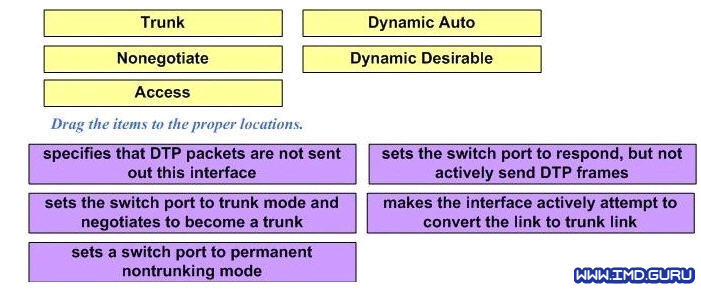CCNP Switch - D&D - DTP Mode

Respuestas correctas:
- Trunk: Set the switch port to trunk mode and negotiate to become a trunk.
- Nonegotiate: Specify that the DTP packets are not sent out of this interface.
- Access: Set a switch port to permanent nontrunking mode.
- Dynamic Auto: Set the switch port to respond, but not actively send DTP frames.
- Dynamic Desirable: Make the interface actively attempt to convert the link to a trunk link. (This means the interface is ready to autonegotiate trunking encapsulation and form a trunk link (using DTP) with a neighbor port in desirable, auto, or on mode.)
Explicación: Dynamic Trunking Protocol (DTP) is the Cisco-proprietary that actively attempts to negotiate a trunk link between two switches. Below is theswitchport modes (or DTP modes) for easy reference:
| Mode | Function |
| Dynamic Auto | Creates the trunk based on the DTP request from the neighboring switch. |
| Dynamic Desirable | Communicates to the neighboring switch via DTP that the interface would like to become a trunk if the neighboring switch interface is able to become a trunk. |
| Trunk | Automatically enables trunking regardless of the state of the neighboring switch and regardless of any DTP requests sent from the neighboring switch. |
| Access | Trunking is not allowed on this port regardless of the state of the neighboring switch interface and regardless of any DTP requests sent from the neighboring switch. |
| Nonegotiate | Prevents the interface from generating DTP frames. This command can be used only when the interface switchport mode is access or trunk. You must manually configure the neighboring interface as a trunk interface to establish a trunk link. |